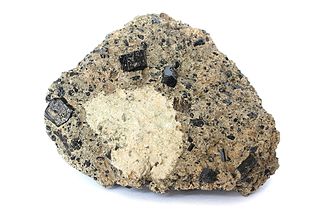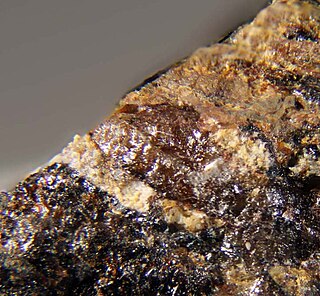Related Research Articles

Gmelinite-Na is one of the rarer zeolites but the most common member of the gmelinite series, gmelinite-Ca, gmelinite-K and gmelinite-Na. It is closely related to the very similar mineral chabazite. Gmelinite was named as a single species in 1825 after Christian Gottlob Gmelin (1792–1860) professor of chemistry and mineralogist from Tübingen, Germany, and in 1997 it was raised to the status of a series.
Gmelinite-Na has been synthesised from Na-bearing aluminosilicate gels. The naturally occurring mineral forms striking crystals, shallow, six sided double pyramids, which can be colorless, white, pale yellow, greenish, orange, pink, and red. They have been compared to an angular flying saucer.

Aenigmatite, also known as Cossyrite after Cossyra, the ancient name of Pantelleria, is a sodium, iron, titanium inosilicate mineral. The chemical formula is Na2Fe2+5TiSi6O20 and its structure consists of single tetrahedral chains with a repeat unit of four and complex side branches. It forms brown to black triclinic lamellar crystals. It has Mohs hardness of 5.5 to 6 and specific gravity of 3.74 to 3.85. Aenigmatite forms a solid-solution series with wilkinsonite, Na2Fe2+4Fe3+2Si6O20.

Warwickite is an iron magnesium titanium borate mineral with the chemical formula (MgFe)3Ti(O, BO3)2orMg(Ti,Fe3+, Al)(BO3)O. It occurs as brown to black prismatic orthorhombic crystals which are vitreous and transparent. It has a Mohs hardness of 3 to 4 and a specific gravity of 3.36.

Lorenzenite is a rare sodium titanium silicate mineral with the formula Na2Ti2Si2O9 It is an orthorhombic mineral, variously found as colorless, grey, pinkish, or brown crystals.

The mineral zektzerite is a member of the tuhualite group and was first found in 1966 by Seattle mineralogist Benjamin Bartlett "Bart" Cannon. It was discovered in the Willow creek basin below Silver Star mountain in miarolitic cavities within the alkaline arfvedsonite granite phase of the Golden Horn batholith, Okanogan County, Washington. It is named for Jack Zektzer, mathematician and mineral collector of Seattle, Washington.

Vishnevite, or sulfatic cancrinite, is a mineral of the cancrinite group with the chemical formula (Na, Ca, K)6(Si, Al)12O24[(SO4),(CO3), Cl2]2-4·nH2O. It has hexagonal crystals.
Alluaivite is a rare mineral of the eudialyte group, with complex formula written as Na19(Ca,Mn)6(Ti,Nb)3Si26O74Cl·2H2O. It is unique among the eudialyte group as the only titanosilicate (other representatives of the group are usually zirconosilicates). The two dual-nature minerals of the group, being both titano- and zirconosilicates, are labyrinthite and dualite. They both contain alluaivite module in their structures. Alluaivite is named after Mt. Alluaiv in Lovozero Tundry massif, Kola Peninsula, Russia, where it is found in ultra-agpaitic, hyperalkaline pegmatites.
Almarudite is an extremely rare alkaline manganese beryllium silicate mineral of the cyclosilicates class, with the chemical formula K([ ],Na)2(Mn2+,Fe2+,Mg)2(Be,Al)3[Si12O30], from the volcanic environment of the Eifel Mountains in Germany.
Alsakharovite-Zn (IMA symbol: Ask-Zn) is an extremely rare alkaline strontium zinc titanium silicate mineral from the cyclosilicates class, with the chemical formula NaSrKZn(Ti,Nb)4(Si4O12)2(O,OH)4·7H2O, from alkaline pegmatites. It belongs to the labuntsovite group.

Kaersutite is a dark brown to black double chain calcic titanium bearing amphibole mineral with formula: NaCa2(Mg3Ti4+Al)(Si6Al2)O22(O)2.
Bystrite is a silicate mineral with the formula (Na,K)7Ca(Si6Al6)O24S4.5•(H2O), and a member of the cancrinite mineral group. It is a hexagonal crystal, with a 3m point group. The mineral may have been named after the Malaya Bystraya deposits in Russia, where it was found.
Banalsite is a rare barium, sodium aluminium silicate mineral with formula: BaNa2Al4Si4O16. Banalsite is a tectosilicate of the feldspar group.
Nabalamprophyllite has a general formula of Ba(Na,Ba){Na3Ti[Ti2O2Si4O14](OH,F)2}. The name is given for its composition and relation to other lamprophyllite-group minerals. Lamprophyllite is a rare Ti-bearing silicate mineral usually found in intrusive igneous rocks.
Kochite is a rare silicate mineral with chemical formula of (Na,Ca)3Ca2(Mn,Ca)ZrTi[(F,O)4(Si2O7)2] or double that. Kochite is a member of the rosenbuschite group.
Dualite is a very rare and complex mineral of the eudialyte group, its complexity being expressed in its formula Na
30(Ca,Na,Ce,Sr)
12(Na,Mn,Fe,Ti)
6Zr
3Ti
3MnSi
51O
144(OH,H
2O,Cl)
9. The formula is simplified as it does not show the presence of cyclic silicate groups. The name of the mineral comes from its dual nature: zircono- and titanosilicate at once. Dualite has two modules in its structure: alluaivite one and eudialyte one. After alluaivite and labyrinthite it stands for third representative of the eudialyte group with essential titanium.
Labyrinthite is a very rare mineral of the eudialyte group. When compared to other species in the group, its structure is extremely complex - with over 100 sites and about 800 cations and anions - hence its name, with its complexity expressed in its chemical formula (Na,K,Sr)35Ca12Fe3Zr6TiSi51O144(O,OH,H2O)9Cl3. The formula is simplified as it does not show the presence of cyclic silicate groups. Complexity of the structure results in symmetry lowering from the typical centrosymmetrical group to R3 space group. Other eudialyte-group representatives with such symmetry lowering include aqualite, oneillite, raslakite, voronkovite. Labyrinthite is the second dual-nature representative of the group after dualite and third with essential titanium after dualite and alluaivite.

Rastsveatevite is a rare mineral of the eudialyte group with the chemical formula Na27K8Ca12Fe3Zr6Si4[Si3O9]4[Si9O27]4(O,OH,H2O)6Cl2. Its structure is modular. It is only the third member of the group after andrianovite and davinciite with essential (site-dominating) potassium. Potassium and sodium enter both N4 and M2 sites. The mineral is named after Russian crystallographer Ramiza K. Rastsvetaeva.
Faizievite is a very rare mineral with the formula K2Na(Ca6Na)Ti4Li6Si24O66F2. This triclinic mineral is chemically related to baratovite and katayamalite. Faizievite is a single-locality mineral, coming from the moraine of the Darai-Pioz glacier, Tien Shan Mountains, Tajikistan. Alkaline rocks of this site are famous for containing numerous rare minerals, often enriched in boron, caesium, lithium, titanium, rare earth elements, barium, and others.

Jinshajiangite is a rare silicate mineral named after the Jinshajiang river in China. Its currently accepted formula is BaNaFe4Ti2(Si2O7)2O2(OH)2F. It gives a name of the jinshajiangite group. The mineral is associated with alkaline rocks. In jinshajiangite, there is a potassium-to-barium, calcium-to-sodium, manganese-to-iron and iron-to-titanium diadochy substitution. Jinshajiangite is the iron-analogue of surkhobite and perraultite. It is chemically related to bafertisite, cámaraite and emmerichite. Its structure is related to that of bafertisite. Jinshajiangite is a titanosilicate with heteropolyhedral HOH layers, where the H-layer is a mixed tetrahedral-octahedral layer, and the O-layer is simply octahedral.
Balliranoite ((Na,K)6Ca2(Si6Al6O24)Cl2(CO)3) is a mineral that was discovered at Monte Somma – Vesuvio volcanic complex, Campania, Italy. This mineral is named in honor of Paolo Ballirano (b. 1964), Italian crystallographer and professor in the Department of Earth Sciences, University of Rome ‘‘La Sapienza’’, who has made important contributions to the crystal chemistry of cancrinite-group minerals.
References
- ↑ Warr, L.N. (2021). "IMA-CNMNC approved mineral symbols". Mineralogical Magazine. 85 (3): 291–320. Bibcode:2021MinM...85..291W. doi: 10.1180/mgm.2021.43 . S2CID 235729616.
- 1 2 Ferraris G., Khomyakov A. P.,and Ivaldi G. 1995: Altisite Na3K6Ti2[Al2Si8O26]Cl3 a new hyperalkaline aluminosilicate from Kola Peninsula (Russia) related to lemoynite: Crystal structure and thermal evolution. Eur. J. Mineral., 7, 537–546 in Jambor J. L., Pertsev N. N. i Roberts A. C. 1996: New mineral names. Am. Min., 81, 516-520,
- ↑ http://www.mindat.org/min-150.html Mindat
- ↑ http://webmineral.com/data/Altisite.shtml Webmineral